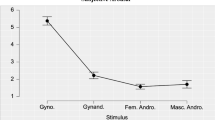Abstract
Faces and bodies convey important information for the identification of potential sexual partners, yet clothing typically covers many of the bodily cues relevant for mating and reproduction. In this eye tracking study, we assessed how men and women viewed nude and clothed, same and opposite gender human figures. We found that participants inspected the nude bodies more thoroughly. First fixations landed almost always on the face, but were subsequently followed by viewing of the chest and pelvic regions. When viewing nude images, fixations were biased away from the face towards the chest and pelvic regions. Fixating these regions was also associated with elevated physiological arousal. Overall, men spent more time looking at female than male stimuli, whereas women looked equally long at male and female stimuli. In comparison to women, men spent relatively more time looking at the chests of nude female stimuli whereas women spent more time looking at the pelvic/genital region of male stimuli. We propose that the augmented and gender-contingent visual scanning of nude bodies reflects selective engagement of the visual attention circuits upon perception of signals relevant to choosing a sexual partner, which supports mating and reproduction.





Similar content being viewed by others
References
Alexander, G. M., & Charles, N. (2009). Sex differences in adults’ relative visual interest in female and male faces, toys, and play styles. Archives of Sexual Behavior, 38, 434–441.
Allison, T., Puce, A., & McCarthy, G. (2000). Social perception from visual cues: Role of the STS region. Trends in Cognitive Sciences, 4, 267–278.
Bocher, M., Chisin, R., Parag, Y., Freedman, N., Weil, Y. M., Lester, H., … Bonne, O. (2001). Cerebral activation associated with sexual arousal in response to a pornographic clip: A O-15-H2O, PET study in heterosexual men. NeuroImage, 14, 105–117.
Bradley, M. M., & Lang, P. J. (1994). Measuring emotion: The self-assessment mannequin and the semantic differential. Journal of Behavior Therapy and Experimental Psychiatry, 25, 49–59.
Buss, D. M., & Barnes, M. (1986). Preferences in human mate selection. Journal of Personality and Social Psychology, 50, 559–570.
Buss, D. M., & Schmitt, D. P. (1993). Sexual strategies theory: An evolutionary perspective on human mating. Psychological Review, 100, 204–232.
Caldara, R., Zhou, X., & Miellet, S. B. (2010). Putting culture under the Spotlight reveals universal information use for face recognition. PLoS ONE, 5, e9708.
Calder, A. J., & Young, A. W. (2005). Understanding facial identity and facial expression recognition. Nature Reviews Neuroscience, 6, 641–651.
Calvo, M. G., & Lang, P. J. (2004). Gaze patterns when looking at emotional pictures: Motivationally biased attention. Motivation and Emotion, 28, 221–243.
Calvo, M. G., & Nummenmaa, L. (2008). Detection of emotional faces: Salient physical features guide effective visual search. Journal of Experimental Psychology: General, 137, 471–494.
Calvo, M. G., & Nummenmaa, L. (2009). Eye-movement assessment of the time course in facial expression recognition: Neurophysiological implications. Cognitive, Affective, & Behavioral Neuroscience, 9, 398–411.
Changizi, M. A., Zhang, Q., & Shimojo, S. (2006). Bare skin, blood and the evolution of primate colour vision. Biology Letters, 2, 217–221.
Cornelissen, P. L., Hancock, P. J. B., Kiviniemi, V., George, H. R., & Tovee, M. J. (2009). Patterns of eye movements when male and female observers judge female attractiveness, body fat and waist-to-hip ratio. Evolution and Human Behavior, 30, 417–428.
Costa, M., Braun, C., & Birbaumer, N. (2003). Gender differences in response to pictures of nudes: A magnetoencephalographic study. Biological Psychology, 63, 129–147.
Costell, R. M., Lunde, D. T., Kopell, B. S., & Wittner, W. K. (1972). Contingent negative variation as an indicator of sexual object preference. Science, 177, 718–720.
Dabbs, J. M. (1997). Testosterone and pupillary response to auditory sexual stimuli. Physiology & Behavior, 62, 909–912.
de Gelder, B., Van den Stock, J., Meeren, H. K. M., Sinke, C. B. A., Kret, M. E., & Tamietto, M. (2010). Standing up for the body: Recent progress in uncovering the networks involved in the perception of bodies and bodily expressions. Neuroscience and Biobehavioral Reviews, 34, 513–527.
Deaner, R. O., Khera, A. V., & Platt, M. L. (2005). Monkeys pay per view: Adaptive valuation of social images by rhesus macaques. Current Biology, 15, 543–548.
Dixson, B., Grimshaw, G., Linklater, W., & Dixson, A. (2009). Eye-tracking of men’s preferences for waist-to-hip ratio and breast size of women. Archives of Sexual Behavior, 40, 43–50.
Francken, A. B., van de Wiel, H. B. M., van Driel, M. F., & Weijmar Schultz, W. C. M. (2002). What importance do women attribute to the size of the penis? European Urology, 42, 426–431.
Frederick, D. A., & Haselton, M. G. (2007). Why is muscularity sexy? Tests of the fitness indicator hypothesis. Personality and Social Psychology Bulletin, 33, 1167–1183.
Ghazanfar, A. A., & Santos, L. R. (2004). Primate brains in the wild: The sensory bases for social interactions. Nature Reviews Neuroscience, 5, 603–616.
Grammer, K., Fink, B., Moller, A. P., & Thornhill, R. (2003). Darwinian aesthetics: Sexual selection and the biology of beauty. Biological Reviews, 78, 385–407.
Hari, R., & Kujala, M. V. (2009). Brain basis of human social interaction: From concepts to brain imaging. Physiological Reviews, 89, 453–479.
Haxby, J. V., Hoffman, E. A., & Gobbini, M. I. (2000). The distributed human neural system for face perception. Trends in Cognitive Sciences, 4, 223–233.
Henderson, J. M. (2003). Human gaze control during real-world scene perception. Trends in Cognitive Sciences, 7, 498–504.
Hewig, J., Trippe, R. H., Hecht, H., Straube, T., & Miltner, W. H. R. (2008). Gender differences for specific body regions when looking at men and women. Journal of Nonverbal Behavior, 32, 67–78.
Hietanen, J. K., & Nummenmaa, L. (2011). The naked truth: The face and body sensitive N170 response is enhanced for nude bodies. PLoS One, 6(11), e24408.
Janelle, C. M., Hausenblas, H. A., Ellis, R., Coombes, S. A., & Duley, A. R. (2009). The time course of attentional allocation while women high and low in body dissatisfaction view self and model physiques. Psychology & Health, 24, 351–366.
Jasienska, G., Ziomkiewicz, A., Ellison, P. T., Lipson, S. F., & Thune, I. (2004). Large breasts and narrow waists indicate high reproductive potential in women. Proceedings of the Royal Society B: Biological Sciences, 271, 1213–1217.
Jiang, Y., Costello, P., Fang, F., Huang, M., & He, S. (2006). A gender- and sexual orientation-dependent spatial attentional effect of invisible images. Proceedings of the National Academy of Sciences, 103, 17048–17052.
Kittler, R., Kayser, M., & Stoneking, M. (2003). Molecular evolution of Pediculds humanus and the origin of clothing. Current Biology, 13, 1414–1417.
Kvavadze, E., Bar-Yosef, O., Belfer-Cohen, A., Boaretto, E., Jakeli, N., Matskevich, Z., & Meshveliani, T. (2009). 30,000-year-old wild flax fibers. Science, 325, 1359.
Lang, P. J. (1995). The emotion probe: Studies of motivation and attention. American Psychologist, 50, 372–385.
Langton, S. R. H., Law, A. S., Burton, A. M., & Schweinberger, S. R. (2008). Attention capture by faces. Cognition, 107, 330–342.
Lindsey, D. T., Brown, A. M., Reijnen, E., Rich, A. N., Kuzmova, Y. I., & Wolfe, J. M. (2010). Color channels, not color appearance or color categories, guide visual search for desaturated color targets. Psychological Science, 21, 1208–1214.
Lykins, A. D., Meana, M., & Kambe, G. (2006). Detection of differential viewing patterns to erotic and non-erotic stimuli using eye-tracking methodology. Archives of Sexual Behavior, 35, 569–575.
Lykins, A. D., Meana, M., & Strauss, G. P. (2008). Sex differences in visual attention to erotic and non-erotic stimuli. Archives of Sexual Behavior, 37, 219–228.
Miller, G. F. (1998). How mate choice shaped human nature: A review of sexual selection and human evolution. In C. Crawford & D. Krebs (Eds.), Evolution and human behavior: Ideas, issues, and applications (pp. 87–93). Hillsdale, NJ: Lawrence Erlbaum.
Minnebusch, D. A., & Daum, I. (2009). Neuropsychological mechanisms of visual face and body perception. Neuroscience and Biobehavioral Reviews, 33, 1133–1144.
Most, S. B., Smith, S. D., Cooter, A. B., Levy, B. N., & Zald, D. H. (2007). The naked truth: Positive, arousing distractors impair rapid target perception. Cognition and Emotion, 21, 964–981.
Nummenmaa, L., Hyönä, J., & Calvo, M. G. (2006). Eye movement assessment of selective attentional capture by emotional pictures. Emotion, 6, 257–268.
Nummenmaa, L., Hyönä, J., & Calvo, M. G. (2009). Emotional scene content drives the saccade generation system reflexively. Journal of Experimental Psychology: Human Perception and Performance, 35, 305–323.
Nummenmaa, L., Hyönä, J., & Hietanen, J. K. (2009). I’ll walk this way: Eyes reveal the direction of locomotion and make passersby look and go the other way. Psychological Science, 20, 1454–1458.
Peelen, M. V., & Downing, P. E. (2007). The neural basis of visual body perception. Nature Reviews Neuroscience, 8, 636–648.
Pouliot, M. C., Despres, J. P., Lemieux, S., Moorjani, S., Bouchard, C., Tremblay, A., … Lupien, P. J. (1994). Waist circumference and abdominal sagittal diameter–Best simple anthropometric indexes of abdominal visceral adipose-tissue accumulation and related cardiovascular risk in men and women. American Journal of Cardiology, 73, 460–468.
Quinsey, V. L., Ketsetzis, M., Earls, C., & Karamanoukian, A. (1996). Viewing time as a measure of sexual interest. Ethology and Sociobiology, 17, 341–354.
Rhodes, G. (2006). The evolutionary psychology of facial beauty. Annual Review of Psychology, 57, 199–226.
Rule, N. O., & Ambady, N. (2008). The face of success: Inferences from chief executive officers’ appearance predict company profits. Psychological Science, 19, 109–111.
Saunders, D. R., Williamson, D. K., & Troje, N. F. (2010). Gaze patterns during perception of direction and gender from biological motion. Journal of Vision, 10. doi:10.1167/10.11.9.
Schiffer, B., Krueger, T., Paul, T., de Greiff, A., Forsting, M., Leygraf, N., … Gizewski, E. (2008). Brain response to visual sexual stimuli in homosexual pedophiles. Journal of Psychiatry & Neuroscience, 33, 23–33.
Sell, R. L. (1996). The Sell Assessment of Sexual Orientation: Background and scoring. Journal of Lesbian, Gay and Bisexual Identity, 1, 295–310.
Shimojo, S., Simion, C., Shimojo, E., & Scheier, C. (2003). Gaze bias both reflects and influences preference. Nature Neuroscience, 6, 1317–1322.
Singh, D. (1993). Adaptive significance of female physical attractiveness: Role of waist-to-hip ratio. Journal of Personality and Social Psychology, 65, 293–307.
Stulhofer, A. (2006). How (un)important is penis size for women with heterosexual experience [Letter to the Editor]? Archives of Sexual Behavior, 35, 5–6.
Theeuwes, J., & Van der Stigchel, S. (2006). Faces capture attention: Evidence from inhibition of return. Visual Cognition, 13, 657–665.
Todorov, A., Said, C. P., Engell, A. D., & Oosterhof, N. N. (2008). Understanding evaluation of faces on social dimensions. Trends in Cognitive Sciences, 12, 455–460.
Walen, S. R., & Roth, D. (1987). A cognitive approach. In J. H. Geer & W. T. O’Donohue (Eds.), Theories of human sexuality (pp. 335–362). New York: Plenum Press.
Wandell, B. A. (1995). Foundations of vision. Sunderland, MA: Sinauer.
Acknowledgments
This research was supported by the AivoAalto grant from the Aalto University, and Academy of Finland (Grant # 251125 to LN). We thank Sanni Aalto, Jenny Wahlström, and Anna Backström for their help with data acquisition.
Author information
Authors and Affiliations
Corresponding author
Rights and permissions
About this article
Cite this article
Nummenmaa, L., Hietanen, J.K., Santtila, P. et al. Gender and Visibility of Sexual Cues Influence Eye Movements While Viewing Faces and Bodies. Arch Sex Behav 41, 1439–1451 (2012). https://doi.org/10.1007/s10508-012-9911-0
Received:
Revised:
Accepted:
Published:
Issue Date:
DOI: https://doi.org/10.1007/s10508-012-9911-0




